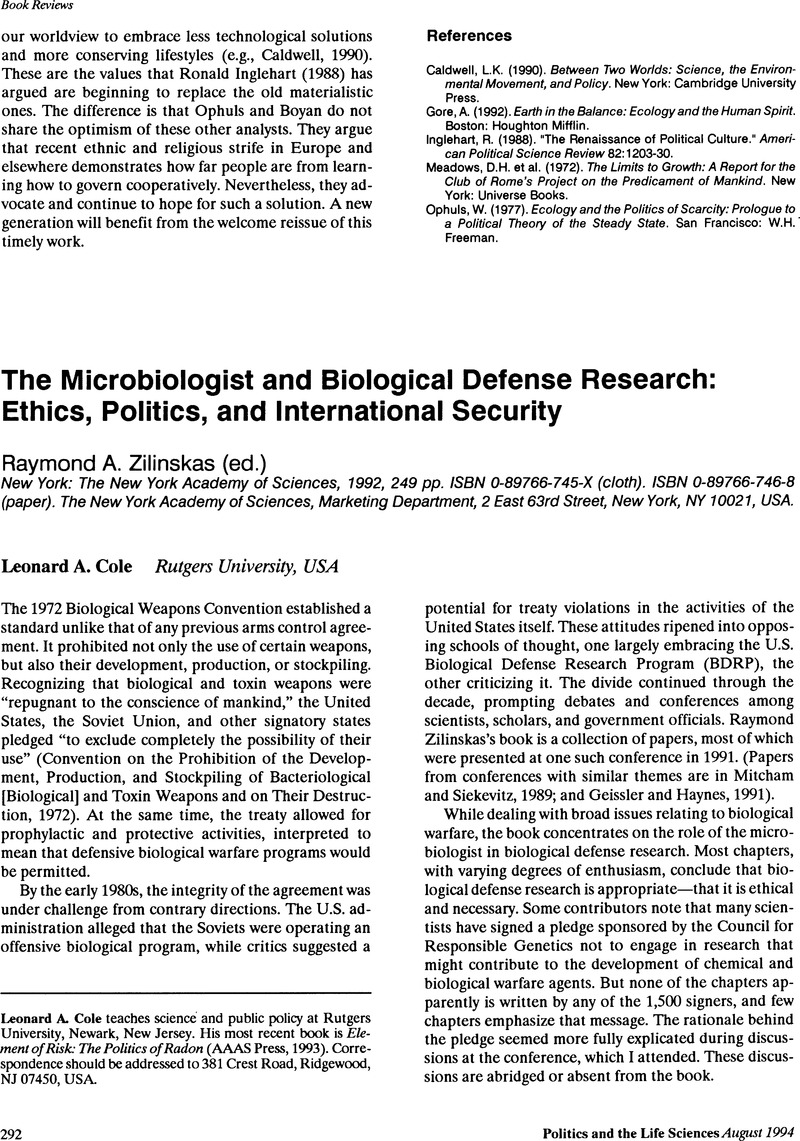No CrossRef data available.
Article contents
The Microbiologist and Biological Defense Research: Ethics, Politics, and International Security. Raymond A. Zilinskas (ed.). New York: The New York Academy of Sciences, 1992, 249 pp. ISBN 0-89766-745-X (cloth). ISBN 0-89766-746-8 (paper). The New York Academy of Sciences, Marketing Department, 2 East 63rd Street, New York, NY 10021, USA.
Published online by Cambridge University Press: 17 May 2016
Abstract
An abstract is not available for this content so a preview has been provided. Please use the Get access link above for information on how to access this content.

- Type
- Book Reviews
- Information
- Copyright
- Copyright © Association for Politics and the Life Sciences
References
Clendenin, R.M. (1968). Science and Technology at Fort Detrick, 1943-1968. Frederick, MD: Fort Detrick, Historian, Technical Information Division.Google Scholar
Cole, L.A. (1988). Clouds of Secrecy: The Army's Germ Warfare Tests over Populated Areas. Totowa, NJ: Rowman and Littlefield.Google Scholar
Convention on the Prohibition of the Development, Production, and Stockpiling of Bacteriological (Biological) and Toxin Weapons and on Their Destruction (1972). Opened for Signature at London, Moscow, and Washington, DC: April 10.Google Scholar
Geissler, E. and Haynes, R.H., eds. (1991). Prevention of a Biological and Toxin Arms Race and the Responsibility of Science. Berlin: Akademie-Verlag.Google Scholar
General Accounting Office, U.S. Congress (1988). DOD's Risk Assessment and Safeguards Management of Chemical and Biological Warfare Research and Development Facilities. GAO/T-PEMD-88-10. Washington, DC: General Accounting Office.Google Scholar
General Accounting Office, U.S. Congress (1990). Biological Warfare: Better Controls in DOD's Research Could Prevent Unneeded Expenditures. GAO/NSIAD-91-68. Washington, DC: General Accounting Office.Google Scholar
King, J. and Strauss, H. (1990). “The Hazards of Defensive Biological Warfare Programs.” In Wright, S. (ed.), Preventing a Biological Arms Race. Cambridge, MA: MIT Press.Google Scholar
Mitcham, C. and Siekevitz, P., eds. (1989). Ethical Issues Associated with Scientific and Technological Research for the Military. New York: The New York Academy of Sciences.Google Scholar
Occupational Safety and Health Administration, U.S. Department of Labor (1991). Evaluation of the U.S. Department of the Army's Occupation Safety and Health Program for the Chemical and Biological Defense Research Laboratories. February.Google Scholar
U.S. Senate (1988). Report of the Majority Staff of the Senate Subcommittee on Oversight of Government Management of DOD's Safety Programs for Chemical and Biological Warfare Research. Mimeo., May 11.Google Scholar




